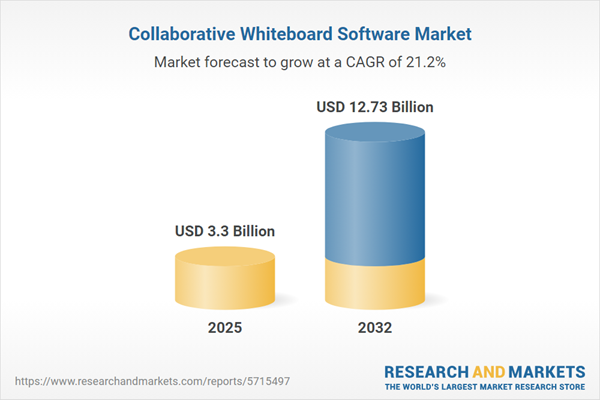Speak directly to the analyst to clarify any post sales queries you may have.
Collaborative whiteboard software is transforming digital collaboration for enterprises, making it possible to connect distributed teams, streamline workflows, and drive informed decision-making in diverse operating environments. This shift toward integrated digital workspaces signals an essential evolution for organizations responding to new business realities and employee expectations.
Market Snapshot: Collaborative Whiteboard Software Market
The collaborative whiteboard software market is expanding rapidly due to the widespread adoption of remote and hybrid work models. In 2024, its value is USD 2.73 billion, and forecasts show growth to USD 3.30 billion by 2025. This represents a compound annual growth rate of 21.22%. Sectors such as finance, healthcare, technology, and manufacturing are integrating these platforms at scale. The primary drivers include centralizing workflows, enhancing cross-functional communication, and improving information management. Enterprises are adopting these digital tools to enable flexible work strategies, remain agile, and support their ongoing digital transformation initiatives.
Scope & Segmentation of the B2B Software Market
- Deployment Type: Cloud-based solutions improve scalability and ease of access for distributed workforces. On-premises deployments serve organizations requiring strict compliance protocols and detailed data governance.
- Organization Size: Large enterprises often select platforms with advanced administrative controls and integration capabilities. Small and mid-sized businesses favor adaptable pricing models and tools designed to scale seamlessly as their operational needs grow.
- Industry Vertical: Core industries adopting these solutions include banking, education, healthcare, IT, manufacturing, public sector, and retail. These platforms help streamline compliance workflows, elevate training initiatives, and support cross-location collaboration essential for operational consistency.
- Application: Usage scenarios span digital brainstorming, project management, employee onboarding, and alignment meetings. This enables teams to collaborate effectively regardless of physical location and to adapt quickly to shifting priorities.
- Geographic Coverage: Adoption is strong across the Americas, Europe, Middle East and Africa, and Asia-Pacific. Vendors customize features to match local infrastructure requirements and comply with regional regulations.
- Company Coverage: Industry leaders such as Miro Inc., Microsoft Corporation, MURAL Inc., Google LLC, Lucid Software, InVisionApp, Stormboard, Conceptboard, Limnu, and Collaboard invest in customer support, product innovation, and partnerships that address a wide array of enterprise demands.
Key Takeaways for Senior Decision-Makers
- Cloud-native architectures in collaborative whiteboard solutions provide secure, flexible access for organizations adapting to new work structures and evolving business needs.
- Integration with video conferencing platforms and AI-powered features supports more dynamic engagement, allowing teams to remain productive and responsive across geographic boundaries.
- Open APIs and automation features help accelerate onboarding and ongoing workflow optimization, simplifying adoption for enterprises with complex operational systems.
- Data security requirements and compliance with local regulations are primary considerations when selecting between cloud-based and on-premises options, especially in highly regulated sectors.
- Continuous investment by vendors in platform enhancements, dedicated support, and strategic alliances ensures that collaboration tools remain aligned with enterprise transformation goals and operational resilience mandates.
Tariff Impact: Supply Chain Considerations
Changing tariff frameworks in the United States have influenced how organizations approach supply chain management in collaborative whiteboard software deployments. Many enterprises now emphasize hardware-agnostic platforms, diversification of supplier relationships, and relocations of parts of their operations to reduce tariff exposure. These strategies mitigate risk and guarantee business continuity, critical for enterprise clients with stringent uptime and reliability expectations.
Methodology & Data Sources
This report synthesizes research from leading industry databases, direct insight from senior enterprise professionals, and analysis of stakeholder case studies. By combining quantitative metrics with practical feedback, the study delivers detailed context on the drivers, adoption pathways, and outcomes associated with collaborative whiteboard software.
Why This Report Matters
- Delivers actionable recommendations for aligning collaborative whiteboard solutions with digital transformation roadmaps and evolving operational priorities.
- Provides benchmarking guidance around deployment strategies, compliance, and workflow integration to help facilitate successful change management across B2B environments.
- Enables executives to recognize and overcome typical adoption obstacles, leading to stronger team innovation and improved cross-region synergy in remote and hybrid workplaces.
Conclusion
Collaborative whiteboard software platforms support enterprise efforts to streamline project execution and build cohesive team partnerships, reinforcing organizational readiness for ongoing digital evolution and long-term operational strength.
Additional Product Information:
- Purchase of this report includes 1 year online access with quarterly updates.
- This report can be updated on request. Please contact our Customer Experience team using the Ask a Question widget on our website.
Table of Contents
3. Executive Summary
4. Market Overview
7. Cumulative Impact of Artificial Intelligence 2025
Companies Mentioned
The companies profiled in this Collaborative Whiteboard Software market report include:- Miro Inc.
- Microsoft Corporation
- MURAL, Inc.
- Google LLC
- Lucid Software, Inc.
- InVisionApp, Inc.
- Stormboard Inc.
- Conceptboard GmbH
- Limnu, Inc.
- Collaboard AG
Table Information
| Report Attribute | Details |
|---|---|
| No. of Pages | 181 |
| Published | October 2025 |
| Forecast Period | 2025 - 2032 |
| Estimated Market Value ( USD | $ 3.3 Billion |
| Forecasted Market Value ( USD | $ 12.73 Billion |
| Compound Annual Growth Rate | 21.2% |
| Regions Covered | Global |
| No. of Companies Mentioned | 11 |









